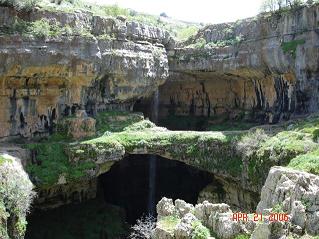Tannourine
Profile Altitude:
1500m
Distance from Beirut: 75km
Getting
There
From
Beirut, take the highway toward the north of Lebanon, Nahr El Kalb tunnel,
Jounieh, Jbeil, head east towards A'nnaya (follow Tannourine's sign), Ehmej,
Laklouk. At the main road in Laklouk turn left (follow Tannourine's sign). |

|
General Information
Tannourine, a Syriac word that means many tannours, a tannour is an old stone
oven, the first people that came to the village founded many tannours in
Tannourine al faw2a at first and later they founded more tannours down the
valley and they called it Tannourine el ta7ta.
Tannourine lies in a splendidly beautiful area near the mountain of the same
name. The area is rocky and mountainous with sharp slopes and a deep valley
(Ain El Raha).
The village also shares its name with a cedar forest of some
60,000 trees. The most abundant and sacred trees are the Cedars and this area
is distinctive as native land for Cedrus Libani. These cedars can be seen
along the road that goes north to Hadath al-Jebbeh, which, although in poor
condition, winds its way through wild and isolated scenery up to the Qadisha
gorge.
Other companion trees like Cupressus, Pinus, Abies, Populus and other
constitute a very rich ecosystem in planter species. The fauna described as
being present in this type of unique ecosystem renage from the various types
of birds (eagles, owls, robins, etc...) to wild animals (hyenas, boars,
squirrels, snakes and bats).
 |
|
The Village of Balaa in the Tannourine area is known for its large sink hole.
A 300 meter walk brings you to a dizzying open cavern some 250 meters deep.
Three natural bridges - the middle one is the most spectacular - complete the
scene.
And if you visit in spring you'll also discover an impressive
waterfall some 90 meters high. Besides the sink hole, which will occupy a good
deal of time, the surrounding hills invite exploration. |
In and around Tannourine village are numerous scattered remnants
from pre-Roman, Roman and Byzantine times. The Crusader Church of Mar Challita
is further evidence of its long history and even today the saint is honored in
an annual feast on August 20.
Along the pretty river (Nahr al Joze), which runs through the
wooded Valley of Tannourine are many attractive restaurants offering Lebanese
food. More good restaurants in natural settings are found round Laqlouq.
Tannourine is well known for its ancient monasteries; specially
the convents of St. Shallitah and St. Antonios Hoob.
Information From the Ministry of
Tourism

|